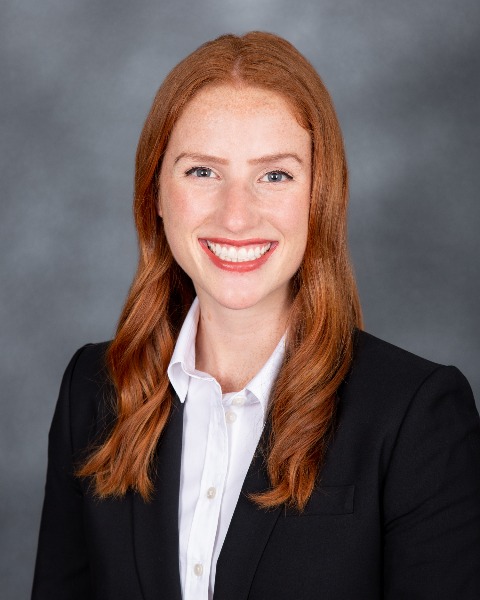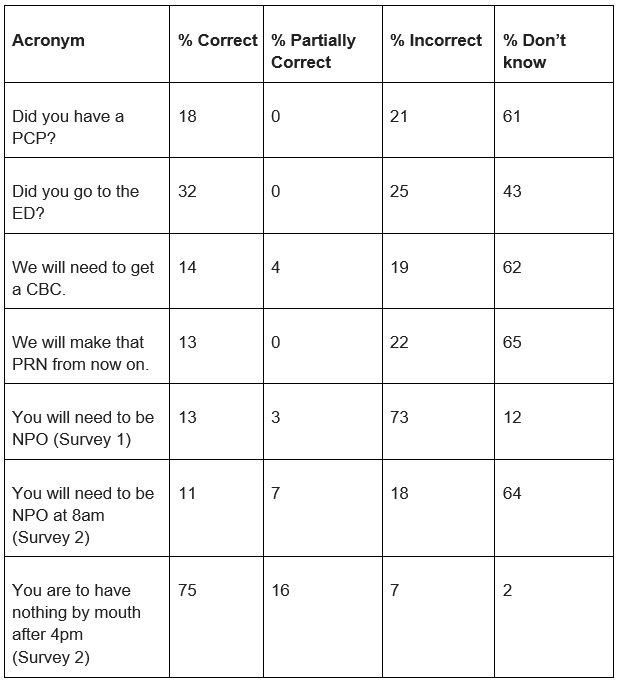General Pediatrics: All Areas
Category: Abstract Submission
General Pediatrics V
101 - CBC, NPO, WTF?: Laypeople's (Mis)Understanding of Acronyms
Monday, April 25, 2022
3:30 PM - 6:00 PM US MT
Poster Number: 101
Publication Number: 101.409
Publication Number: 101.409
Victoria Charpentier, University of Minnesota Medical School, Minneapolis, MN, United States; Katherine A. Allen, University of Minnesota Masonic Children's Hospital, Minneapolis, MN, United States; Corinne Praska, University of Minnesota Medical School, Minneapolis, MN, United States; Rachael Gotlieb, University of Minnesota Medical School, Minneapolis, MN, United States; Emily Hause, University of Minnesota Masonic Children's Hospital, Saint Anthony, MN, United States; Jordan Marmet, University of Minnesota Masonic Children's Hospital, Minneapolis, MN, United States; Marissa A. Hendrickson, University of Minnesota Medical School, Minneapolis, MN, United States; Scott Lunos, University of Minnesota, Minneapolis, MN, United States; Michael B. Pitt, University of Minnesota, Minneapolis, MN, United States

Victoria Charpentier, BS
Medical Student
University of Minnesota Medical School
Minneapolis, Minnesota, United States
Presenting Author(s)
Background: Abbreviations are used often in medicine, yet may be a source of confusion for patients.
Objective: We aimed to determine the general public’s understanding of commonly used acronyms.
Design/Methods: We conducted two unique surveys over three days at the 2021 Minnesota State Fair to assess the understanding of medical acronyms in a cross-section of the Minnesota public. Adults >18 years old who did not have a history of any medical or nursing training volunteered to complete a brief REDCap survey on an iPad. In one survey, participants were given five phrases with acronyms (e.g., “Did you go to the ED?” or “You will need to be NPO.”) The abbreviations assessed were ED, NPO, CBC, PRN, and PCP. Participants were asked to write what they thought each abbreviation meant.
A second survey, given to different participants, looked at pairs of phrases to compare understanding. This survey further evaluated understanding of the abbreviation NPO by asking the meaning of two statements, presented in separate locations in a longer survey: 1) “You will need to be NPO at 8am” and 2) “You are to have nothing by mouth at 4 pm.”
Responses were coded as correct, partially correct, or incorrect/blank by two independent researchers, adding a third researcher if consensus was not reached. We used descriptive statistics to summarize the survey questions, comparing demographics and survey questions between written and verbal groups using a t-test for age and Fisher’s exact tests for categorical variables. McNemar’s test was used to compare correct responses for “NPO” and “nothing by mouth” questions.
Results: There were 204 respondents to the survey which included the five acronyms (55% female; mean age 43). Two thirds (67%) had a bachelor's degree or higher. The table shows the breakdown of their understanding of the acronyms. Four of the five acronyms were correctly defined by less than 20% of respondents. NPO was the least understood; it was accurately described by 13%.
The second survey that included both NPO and nothing by mouth questions had 217 respondents (63% female; mean age 42; 65% had a bachelor’s degree or higher). In this survey, 11% accurately explained the term “NPO” versus 75% when the phrase “nothing by mouth” was used instead (p < 0.0001).Conclusion(s): Medical acronyms are a predictable source of confusion. Less than one in five people accurately understood the acronyms ED, PCP, PRN, CBC, or NPO. More people demonstrated understanding of “nothing by mouth” compared to NPO, yet one in four still misunderstood this phrasing, arguing that further clarity is justified.
Survey
Results: Understanding of Medical Acronyms PCP = Primary Care Provider; ED = Emergency Department; CBC = Complete Blood Count; PRN = pro re nata (as needed); NPO = nil per os (nothing by mouth)
PCP = Primary Care Provider; ED = Emergency Department; CBC = Complete Blood Count; PRN = pro re nata (as needed); NPO = nil per os (nothing by mouth)
Objective: We aimed to determine the general public’s understanding of commonly used acronyms.
Design/Methods: We conducted two unique surveys over three days at the 2021 Minnesota State Fair to assess the understanding of medical acronyms in a cross-section of the Minnesota public. Adults >18 years old who did not have a history of any medical or nursing training volunteered to complete a brief REDCap survey on an iPad. In one survey, participants were given five phrases with acronyms (e.g., “Did you go to the ED?” or “You will need to be NPO.”) The abbreviations assessed were ED, NPO, CBC, PRN, and PCP. Participants were asked to write what they thought each abbreviation meant.
A second survey, given to different participants, looked at pairs of phrases to compare understanding. This survey further evaluated understanding of the abbreviation NPO by asking the meaning of two statements, presented in separate locations in a longer survey: 1) “You will need to be NPO at 8am” and 2) “You are to have nothing by mouth at 4 pm.”
Responses were coded as correct, partially correct, or incorrect/blank by two independent researchers, adding a third researcher if consensus was not reached. We used descriptive statistics to summarize the survey questions, comparing demographics and survey questions between written and verbal groups using a t-test for age and Fisher’s exact tests for categorical variables. McNemar’s test was used to compare correct responses for “NPO” and “nothing by mouth” questions.
Results: There were 204 respondents to the survey which included the five acronyms (55% female; mean age 43). Two thirds (67%) had a bachelor's degree or higher. The table shows the breakdown of their understanding of the acronyms. Four of the five acronyms were correctly defined by less than 20% of respondents. NPO was the least understood; it was accurately described by 13%.
The second survey that included both NPO and nothing by mouth questions had 217 respondents (63% female; mean age 42; 65% had a bachelor’s degree or higher). In this survey, 11% accurately explained the term “NPO” versus 75% when the phrase “nothing by mouth” was used instead (p < 0.0001).Conclusion(s): Medical acronyms are a predictable source of confusion. Less than one in five people accurately understood the acronyms ED, PCP, PRN, CBC, or NPO. More people demonstrated understanding of “nothing by mouth” compared to NPO, yet one in four still misunderstood this phrasing, arguing that further clarity is justified.
Survey
Results: Understanding of Medical Acronyms
 PCP = Primary Care Provider; ED = Emergency Department; CBC = Complete Blood Count; PRN = pro re nata (as needed); NPO = nil per os (nothing by mouth)
PCP = Primary Care Provider; ED = Emergency Department; CBC = Complete Blood Count; PRN = pro re nata (as needed); NPO = nil per os (nothing by mouth)